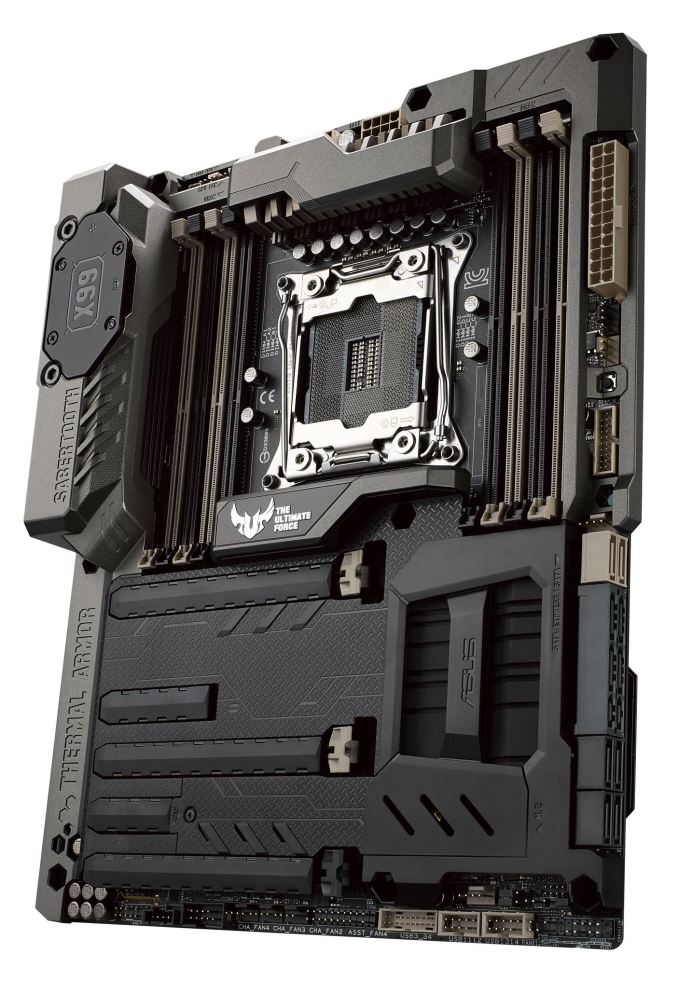The ASUS TUF X99 Sabertooth Review
by Ian Cutress on July 22, 2015 10:00 AM EST- Posted in
- Motherboards
- Asus
- TUF
- X99
ASUS TUF X99 Sabertooth Conclusion
X99 is still the high-end desktop platform and there is no getting away from it. Arguably you could jump in with the cheapest CPU (i7-5820K, $400), the cheapest memory (a single stick of DDR4, $30), a $32 GPU, an $18 HDD, a basic power supply and then focus on the motherboard for perhaps under $700 – but that doesn’t happen. X99 is not the platform that users attempt to scrimp towards, because the mainstream platform can get better performance and functionality for the same cost over a range of metrics. As a result, X99 aims at users who need the performance, the resources and have the wallet to match. Nonetheless, very few are willing to drop a couple of thousand every few quarters for the latest and greatest.
Update cycles for desktops are still in the 3-4 year range, or even longer for business. Failure rates are always up for discussion, though the pull between a cheaper outlay now or a potential outlay in the future is a difficult one to finalize. For end-users looking for a long term system, such as those users who are still on X58 or are early X79 adopters, finding something that fits into the long upgrade cycle while still being capable is a market that ASUS (and recently others) aims at. With the 5-year warranty, this is the aim of the TUF brand.
The 5-year warranty comes about through the promoted use of upgraded components, extra testing in the factory, and general over-engineering above the standard. For the X99 Sabertooth this means the Thermal Armor to protect against warping and port/slot protectors to prevent corrosion, dust or sand, as well as additional temperature and fan sensors to ensure the system is within the right temperature window at all times. To supplement this, the TUF Detective smartphone app will also provide information and control when linked to a specific USB port in the rear.
On the functionality side of things there are a total of eight USB 3.0 ports on the board as well as a pair of USB 3.1 ports (Type-A) on the rear panel in teal-blue. The latter are provided by an ASMedia ASM1142 controller which is the sole controller we’re currently seeing in the marketplace. For storage there is a single SATA Express port (despite the above image showing two holes, but only one is connected) and an M.2 PCIe 3.0 x4 port under part of the Thermal Armor. The latest Sabertooth BIOSes supports NVMe, so with the Hyper Kit we installed an Intel 750 SSD in here, although using the M.2 does disable the bottom PCIe port as the M.2 is connected via CPU lanes to achieve 32 Gbps bandwidth. Networking comes via Intel I218-V and Realtek 8111GR Ethernet ports, while audio is from an enhanced Realtek’s ALC1150 codec solution.
Performance testing throws up nothing out of the ordinary – with the 1801 BIOS we had POST times were long for X99 but the audio performance was near the top of our charts. The Sabertooth by default does not enable MultiCore Turbo, but does have a couple of BIOS based overclocking options to overcome this. Overclock results were in line with our CPU sample on other motherboards. BIOS and Software were well received, including the focus on the software for thermal management rather than overclocking. We have made a couple of suggestions to ASUS for future updates though.
At $310, the ASUS X99 Sabertooth sits in a comfortable median between the other X99 offerings on the market which vary from $210 to over $600. That $300 area is a battleground for the cheaper mid-range models that typically focus on mild aesthetics over a base design. For active functionality, ASUS pulls out of the bag some epic fan control and USB 3.1, with Hyper Kit/NVMe support useful for those that need it. There isn’t anything here that marks it up to the $400 range (3-way/4-way GPU + M.2 or Thunderbolt), and users will have to decide if paying for the 5-year warranty is something worth happening, especially as X99 will probably have some long legs ahead of it.
Take another angle. A new X99 user wants something long term, has one or two GPUs. The Sabertooth offers a long warranty, support for future upgrades, 8-DIMMs, NVMe, M.2 and USB 3.1, with sufficient USB 3.0 and storage for long term use as well as the software to manage a quiet system.












57 Comments
View All Comments
Shadowmaster625 - Wednesday, July 22, 2015 - link
lol it even has dust caps for the microphone port.Stuka87 - Wednesday, July 22, 2015 - link
Really a nice looking board. I like the PCI-E covers one slots you may not be using.Out of curiosity, why are you guys still testing with Windows 7 rather than 8.1? Will you guys be moving to Windows 10 soon?
AndrewJacksonZA - Wednesday, July 22, 2015 - link
As soon as it's commercially available and all benchmark software has been tested to make sure that they still work I hope. :-)Souka - Thursday, July 23, 2015 - link
What about Windows 8.1?abrowne1993 - Wednesday, July 22, 2015 - link
"It didn’t detect the DDR3 on the graphics card correctly though!"GDDR5?
Ryan Smith - Wednesday, July 22, 2015 - link
The R7 240 is a DDR3 card.Achaios - Wednesday, July 22, 2015 - link
@Staff: There is a rather huge issue with ASUS X99 motherboards destroying CPU's (5960X's, 5820k's, etc). Google "5960X Dead overclock.net".To my understanding, there is a chance that the ASUS X99 motherboard will raise on its own the CPU Vcore of the CPU to around 1.85V which, as we have learned, kills CPUs in a matter of seconds.
The latest incident reported was 4.5 hours ago. ASUS has refused to comment or acknowledge the issue. So, in view of the above, I would not buy an ASUS X99.
Achaios - Wednesday, July 22, 2015 - link
Correction: Latest incident reported 2 days and 8 hours ago on a "RVE", i.e. Rampage V Extreme X99. According to the person writing the report, he did try to RMA the board butQUOTE "ASUS were just dismissive and very unfriendly and said no".
Treating enthusiasts like dogs really angers me.
Gothmoth - Wednesday, July 22, 2015 - link
lol.... "enthusiast" who probably killed their system because they have no clue how to overclock.now they claim it´s a board problem. of course all x99 asus boards are affected.
i have SIX asus X99 boards and they run flawless for years.
an where is the source for the "incident" you reported?
without giving a source this is even more likr UFO sightings.....
Achaios - Wednesday, July 22, 2015 - link
http://www.overclock.net/t/1561131/5960x-dead